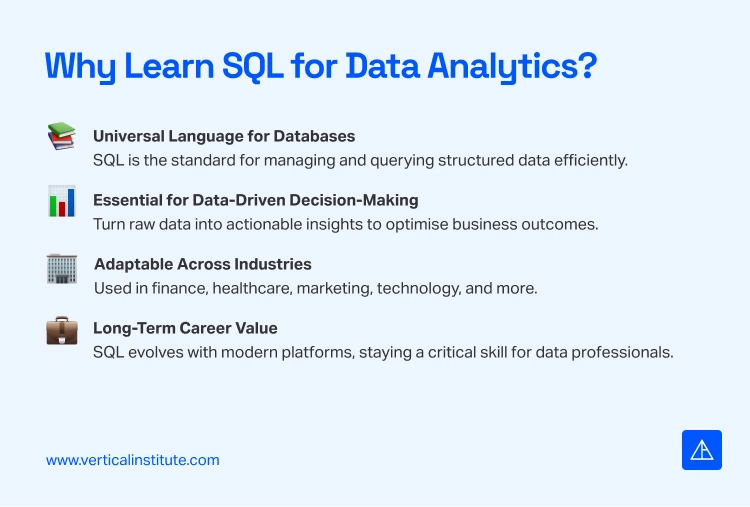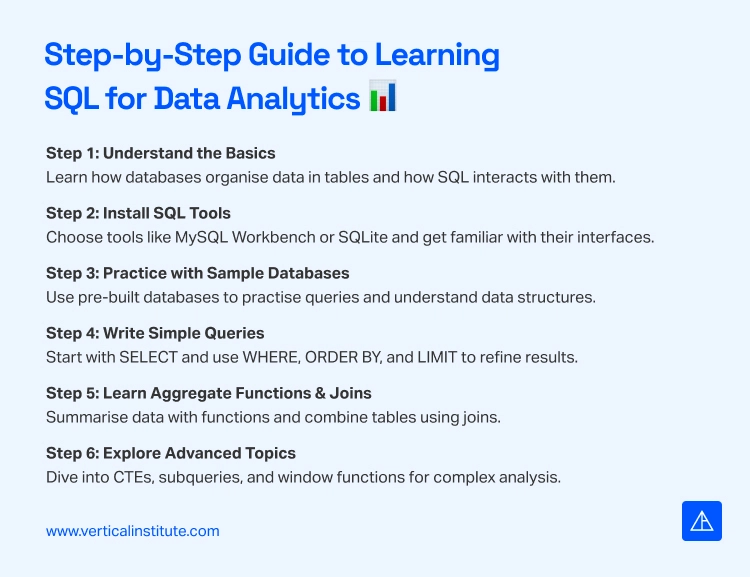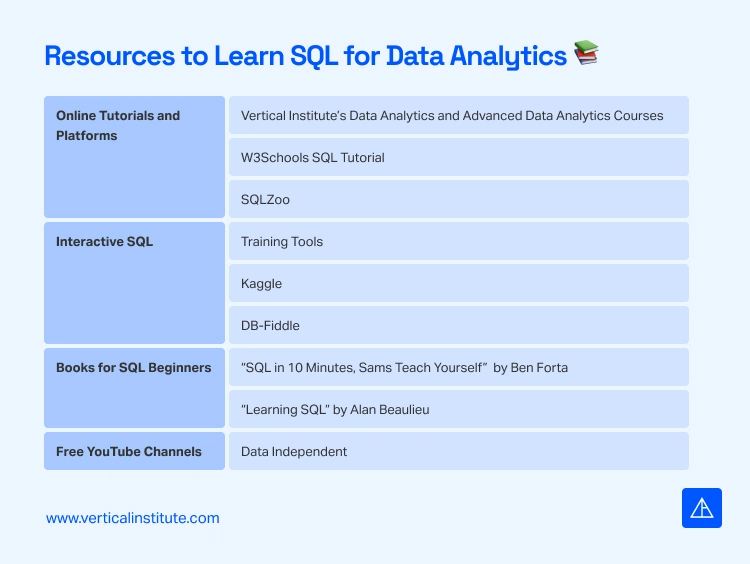SQL, or Structured Query Language, is essential for anyone interested in data analytics. It enables professionals to interact with databases, retrieve data, and generate insights that inform critical decisions. Whether you’re new to data analytics or looking to expand your technical skills, learning SQL is pivotal. As highlighted by TechTarget, SQL’s adaptability and effectiveness have solidified its role as a key technology for managing structured data.
This article is a step-by-step guide for beginners learning SQL for data analytics. It covers the benefits of SQL, fundamental concepts, and practical steps to help you start working with data effectively.
Related Article: A Beginner’s Guide to SQL
Why Learn SQL for Data Analytics?
SQL’s relevance has stood the test of time, making it a skill worth mastering for anyone working with data.
Universal Language for Databases
SQL remains the standard for managing and querying structured databases, enabling users to interact with vast amounts of data efficiently. As noted by InfoWorld, SQL has endured because it provides a consistent, easy-to-use interface for working with relational data.
Essential for Data-Driven Decision-Making
By learning SQL, you can transform raw data into actionable insights, helping businesses optimise operations and improve outcomes.
Adaptable Across Industries
SQL’s functionality is relied upon in finance, healthcare, marketing, and technology sectors. It ensures its value for professionals in diverse fields.
Long-term Career Value
SQL continues to be a core component of data management despite the emergence of new technologies. Its longevity is tied to its ability to evolve with modern data platforms while remaining intuitive for users.

Related Article: How SQL Can Help With Your Future Data Analytics Career
How Does It Benefit Beginners?
For beginners, SQL offers an approachable coding and data analytics learning point. Its straightforward syntax and immediate applicability help new learners build confidence and develop valuable skills for future growth.
Easy to Learn
SQL has a simple and user-friendly syntax, making it an ideal first step for those new to programming or data analytics.
Quick Results
Beginners can immediately apply SQL to retrieve, organise, and analyse data, providing a sense of accomplishment early in the learning process.
Highly Transferable Skills
Knowledge of SQL can be used across different database systems, such as MySQL, PostgreSQL, and Microsoft SQL Server.
Foundation for Advanced Learning
Mastering SQL builds confidence and creates a solid base for learning more complex data analytics tools and techniques.
Related Article: How to Start Programming as a Beginner: 8 Tips to Write Your First Code
Core SQL Concepts Every Beginner Should Know
It’s essential to understand how relational databases work before diving into SQL. Databases store data in tables, which are made up of rows and columns.
Beginners should start with fundamental SQL operations, such as:
- SELECT Queries – Retrieving data from a table.
- WHERE Clauses – Filtering data based on conditions.
- Joins – Combining data from multiple tables.
- Aggregate Functions – Summarising data using COUNT, SUM, AVG, and more.
These concepts form the foundation of SQL and are necessary for performing both simple and advanced analytics. As learners become more comfortable, they can explore advanced techniques like subqueries, Common Table Expressions (CTEs), and window functions, expanding SQL’s capabilities in managing complex data tasks.
A Step-by-Step Guide to Learning SQL for Data Analytics
Here are the key steps to start your SQL learning journey:
Step 1: Understand the Basics of Databases and SQL
- Learn how databases store and organise data in structured tables with rows and columns.
- Explore key concepts like primary keys, foreign keys, and relationships between tables.
- Understand that SQL, or Structured Query Language, is the tool used to query and manage these databases.
Step 2: Install and Explore SQL Tools
- Choose a tool to practice SQL, such as MySQL Workbench, SQL Server Management Studio, or SQLite.
- Familiarise yourself with the interface and basic operations within your chosen tool.
Step 3: Practice with Sample Databases
- Use pre-built sample databases like MySQL’s Sakila or Microsoft’s AdventureWorks to practice.
- Experiment with different queries to explore and modify the data.
Step 4: Write Simple Queries
- Start with basic queries using the SELECT statement to retrieve data.
- Use clauses like WHERE to filter results, ORDER BY to sort, and LIMIT to control the number of rows returned.
Step 5: Learn to Use Aggregate Functions and Joins
- Apply aggregate functions like COUNT, SUM, AVG, MIN, and MAX to summarise data.
- Learn how to use joins, such as INNER JOIN and LEFT JOIN, to combine data from multiple tables.
Step 6: Explore Advanced Topics (CTEs, Subqueries, Window Functions)
- Study Common Table Expressions (CTEs) to simplify complex queries.
- Understand how subqueries work for nested data retrieval.
- Learn window functions for performing advanced analytical tasks.
These steps provide a strong starting point, but there is much more to explore. To deepen your knowledge, enrol in the Data Analytics course at Vertical Institute, where you can complete the programme in just 21 hours and apply what you have learned in a capstone project.

What are the Best Resources to Learn SQL for Data Analytics
Whether you’re just starting or looking to refine your SQL skills, having the right resources can make your learning journey smoother and more effective. Here’s a list of trusted learning resources to kickstart your journey in SQL:
Online Tutorials and Platforms
- Vertical Institute’s Advanced Data Analytics Course
For those looking to take their SQL and data analytics skills to the next level, the Advanced Data Analytics course at Vertical Institute is an excellent option. Participants will explore complex analytical techniques, advanced SQL queries, and tools like Advanced SQL or Tableau to enhance their data-driven decision-making capabilities. By enrolling, learners can build on their existing knowledge and gain the expertise needed to tackle more challenging projects in analytics.
Related Article: Power BI vs. Tableau: What is the Best Data Visualisation Tool to Learn
- W3Schools SQL Tutorial
This globally recognised platform offers beginner-friendly tutorials explaining SQL concepts clearly and exercises to practise what you learn.
- SQLZoo
SQLZoo is an interactive platform that guides learners through step-by-step lessons and hands-on practice problems, making it ideal for building foundational SQL skills.
Interactive SQL Training Tools
- Kaggle
Kaggle offers tutorials and challenges specifically focused on SQL. It allows learners to practise writing queries on real-world datasets and gain a deeper understanding of data analytics.
- DB-Fiddle
This free, browser-based tool allows users to practise SQL queries directly in their web browser, making it a convenient option for testing and learning without installing additional software.
Books for SQL Beginners
- “SQL in 10 Minutes, Sams Teach Yourself” by Ben Forta
This book is a quick and accessible guide for beginners, offering concise lessons on key SQL concepts that can be applied immediately.
- “Learning SQL” by Alan Beaulieu
This detailed book takes readers through the basics of SQL, with real-world examples to help learners understand its applications in data analytics.
Free YouTube Channels
- Data Independent: This channel offers beginner-friendly videos focusing on practical SQL use cases, making complex concepts easier to grasp with real-world examples.

Related article: Top Platforms for Data Analytics and Data Science Datasets
Common SQL Mistakes and How to Avoid Them
Even experienced users can make mistakes when working with SQL, but understanding these common errors can save time and improve efficiency. You can write more efficient and secure SQL queries by being aware of these common pitfalls and addressing them proactively.
Here are some frequent SQL mistakes and how you can avoid them:
- Forgetting to Use Proper Indexing
Neglecting to use indexes can lead to slower query performance, especially when working with large datasets. Always ensure that appropriate columns are indexed to optimise search and retrieval speeds.
- Using SELECT * in Queries
While it might seem convenient, using SELECT * retrieves all columns, which can result in fetching unnecessary data and slowing down performance. Instead, specify only the columns you need in your query.
- Incorrect Joins or Missing Conditions
Writing joins without proper conditions can create Cartesian products, leading to enormous and irrelevant datasets. Always include precise conditions in your ON or WHERE clauses when performing joins.
- Ignoring SQL Injection Risks
Failing to sanitise user inputs can expose your database to SQL injection attacks. Always use parameterised queries or prepared statements to protect your data.
- Not Handling NULL Values Properly
Ignoring NULL values can lead to unexpected results in calculations and comparisons. Use functions like COALESCE or IS NULL to handle NULL values effectively in your queries.
- Overlooking Query Optimisation
Writing inefficient queries can lead to slow performance, especially with complex operations. Always review your query structure and consider using tools like query execution plans to identify bottlenecks.
- Lack of Comments in Queries
Skipping comments can make your queries hard to understand for others (or even yourself later). Always include meaningful comments to explain the purpose of your query or specific steps.
Related Article: Art Meets Data: An Animation Student’s Unexpected Path into Analytics
Conclusion
Learning SQL is essential for anyone looking to excel in data analytics. It empowers you to interact with databases, extract meaningful insights, and solve real-world problems with data. For beginners, SQL offers a user-friendly learning curve, making it accessible to those new to programming or analytics. By practising key concepts such as queries, joins, and aggregate functions, you can build a solid foundation and gradually tackle more advanced tasks. With consistent effort and the right resources, learning SQL can open doors to exciting opportunities in data-driven roles and enhance your ability to make impactful decisions.
Join a Free Workshop on In-Demand Courses
Explore how in-demand AI-integrated skills like SQL can boost your career. Ask questions, meet experts, and see if any of our courses suit you, all at no cost. Sign up with Vertical Institute today!
FREE WORKSHOPS
Explore our free workshops and uncover the skills you need to succeed.
About Vertical Institute
Vertical Institute is shaping the future of work by preparing individuals for tomorrow’s job market. Our courses and certification focus on teaching essential skills and nurturing the next generation of innovators and leaders.
As an Approved Training provider (ATO) accredited by SkillsFuture Singapore (SSG) and the Institute of Banking & Finance Singapore (IBF), our courses adhere to the highest standards. They are government-subsidised and eligible for SkillsFuture Credits or NTUC UTAP Funding.



